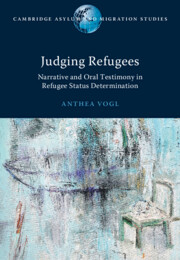549 results
3 - The Toronto Context
-
- Book:
- Heritage Languages
- Print publication:
- 27 June 2024, pp 29-36
-
- Chapter
- Export citation
An examination of health care efficiency in Canada: a two-stage semi-parametric approach
-
- Journal:
- Health Economics, Policy and Law , First View
- Published online by Cambridge University Press:
- 03 June 2024, pp. 1-20
-
- Article
- Export citation
Volunteering among Older Adults and Effects of Ethnic Minority Status before and during the COVID-19 Pandemic: Longitudinal Analyses of the CLSA
-
- Journal:
- Canadian Journal on Aging / La Revue canadienne du vieillissement , First View
- Published online by Cambridge University Press:
- 30 May 2024, pp. 1-12
-
- Article
- Export citation
Operationalizing the Intolerable Suffering Criterion in Advance Requests for Medical Assistance in Dying for People Living with Dementia in Canada
-
- Journal:
- Cambridge Quarterly of Healthcare Ethics , First View
- Published online by Cambridge University Press:
- 22 May 2024, pp. 1-7
-
- Article
-
- You have access
- Open access
- HTML
- Export citation
23 - Toronto the Good, Toronto the Gay: Sex and Morality in the Twentieth Century
-
-
- Book:
- The Cambridge World History of Sexualities
- Published online:
- 26 April 2024
- Print publication:
- 16 May 2024, pp 487-507
-
- Chapter
- Export citation
Partisanship, Independence, and the Constitutive Representation of Women in the Canadian Senate
-
- Journal:
- Politics & Gender , First View
- Published online by Cambridge University Press:
- 15 May 2024, pp. 1-25
-
- Article
-
- You have access
- Open access
- HTML
- Export citation
Development and testing of two tools to assess point-of-sale food and beverage marketing to children in restaurants
-
- Journal:
- Public Health Nutrition / Volume 27 / Issue 1 / 2024
- Published online by Cambridge University Press:
- 06 May 2024, e128
-
- Article
-
- You have access
- Open access
- HTML
- Export citation
Renewable Energy Support Through Feed-in Tariffs: A Retrospective Stakeholder Analysis
-
- Journal:
- Journal of Benefit-Cost Analysis , First View
- Published online by Cambridge University Press:
- 03 May 2024, pp. 1-26
-
- Article
-
- You have access
- Open access
- HTML
- Export citation
Museums, Climate Change and Energy Education: A Digital Discourse Analysis
-
- Journal:
- Australian Journal of Environmental Education , First View
- Published online by Cambridge University Press:
- 02 May 2024, pp. 1-17
-
- Article
-
- You have access
- Open access
- HTML
- Export citation
Glyphosate-resistant and susceptible downy brome (Bromus tectorum) management with soil-applied residual herbicides
-
- Journal:
- Weed Technology / Volume 38 / 2024
- Published online by Cambridge University Press:
- 29 April 2024, e36
-
- Article
-
- You have access
- Open access
- HTML
- Export citation
Crafting British medicine in the Empire: the establishment of medical schools in India and Canada, 1763–1837
-
- Journal:
- Medical History , First View
- Published online by Cambridge University Press:
- 12 April 2024, pp. 1-18
-
- Article
-
- You have access
- Open access
- HTML
- Export citation
Economic Diplomacy and Home State Responsibility for Human Rights Abuses Involving Extractive Industries Abroad: The Case of Canada
-
- Journal:
- Business and Human Rights Journal , First View
- Published online by Cambridge University Press:
- 03 April 2024, pp. 1-7
-
- Article
-
- You have access
- Open access
- HTML
- Export citation
Survey of Canadian Physician Use of Botulinum Toxin A (BoNT-A) for Paratonia: Real World Insights
-
- Journal:
- Canadian Journal of Neurological Sciences , First View
- Published online by Cambridge University Press:
- 01 April 2024, pp. 1-4
-
- Article
-
- You have access
- Open access
- HTML
- Export citation
9 - Australia and North America
- from The Regions
-
-
- Book:
- Australia in World Affairs 1976–1980
- Published online:
- 29 March 2024, pp 145-156
-
- Chapter
- Export citation
1 - Introduction
-
- Book:
- Judging Refugees
- Published online:
- 15 March 2024
- Print publication:
- 28 March 2024, pp 1-22
-
- Chapter
- Export citation
6 - ‘I’ll Just Stop You There’: Fragmentation of Refugees’ Oral Testimony
-
- Book:
- Judging Refugees
- Published online:
- 15 March 2024
- Print publication:
- 28 March 2024, pp 113-135
-
- Chapter
- Export citation

Judging Refugees
- Narrative and Oral Testimony in Refugee Status Determination
-
- Published online:
- 15 March 2024
- Print publication:
- 28 March 2024
Using an intersectionality-based approach to evaluate mental health services use among gay, bisexual and other men who have sex with men in Montreal, Toronto and Vancouver
-
- Journal:
- Epidemiology and Psychiatric Sciences / Volume 33 / 2024
- Published online by Cambridge University Press:
- 05 March 2024, e10
-
- Article
-
- You have access
- Open access
- HTML
- Export citation
12 - The Intonation of Declaratives and Polar Questions in Modern versus Heritage Icelandic
-
-
- Book:
- The Phonetics and Phonology of Heritage Languages
- Published online:
- 15 February 2024
- Print publication:
- 22 February 2024, pp 259-279
-
- Chapter
- Export citation
14 - Have Cantonese Tones Merged in Spontaneous Speech?
-
-
- Book:
- The Phonetics and Phonology of Heritage Languages
- Published online:
- 15 February 2024
- Print publication:
- 22 February 2024, pp 302-320
-
- Chapter
- Export citation



